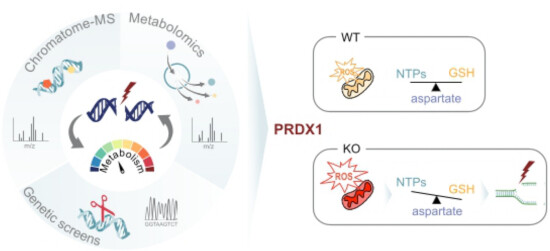



A new study co-led by Savvas Kourtis from our lab and Amandine Moretton from Joanna Loizou’s lab at the CeMM, Vienna reveals that in response to DNA damage, such as from chemotherapy drugs, the nucleus of a cell activates antioxidant enzymes to protect itself. We found that an enzyme called Peroxiredoxin 1 (PRDX1) translocates from the mitochondria to the nucleus to reduce reactive oxygen species and make aspartate available for nucleotide synthesis to repair DNA. This indicates the nucleus is not metabolically inert as previously thought, but rather appropriates mitochondrial machinery as an emergency response. The findings suggest potential new cancer treatment strategies like combining chemotherapy with drugs that boost reactive oxygen species or inhibit nucleotide synthesis to overcome drug resistance.
“PRDX1 is like a robotic pool cleaner. Cells are known to use it to keep their insides ‘clean’ and prevent the accumulation of reactive oxygen species, but never before at the nuclear level. This is evidence that, in a state of crisis, the nucleus responds by appropriating mitochondrial machinery and establishes an emergency rapid-industrialization policy,” says Sara.
Read the actual publication on the journal page: Molecular Systems Biology.
Read the press release on Genetic Engineering & Biotechnology News.
| Cookie | Duration | Description |
|---|---|---|
| cookielawinfo-checbox-analytics | 11 months | This cookie is set by GDPR Cookie Consent plugin. The cookie is used to store the user consent for the cookies in the category "Analytics". |
| cookielawinfo-checbox-functional | 11 months | The cookie is set by GDPR cookie consent to record the user consent for the cookies in the category "Functional". |
| cookielawinfo-checbox-functional | 11 months | The cookie is set by GDPR cookie consent to record the user consent for the cookies in the category "Functional". |
| cookielawinfo-checbox-others | 11 months | This cookie is set by GDPR Cookie Consent plugin. The cookie is used to store the user consent for the cookies in the category "Other. |
| cookielawinfo-checkbox-advertisement | 1 year | The cookie is set by GDPR cookie consent to record the user consent for the cookies in the category "Advertisement". |
| cookielawinfo-checkbox-necessary | 11 months | This cookie is set by GDPR Cookie Consent plugin. The cookies is used to store the user consent for the cookies in the category "Necessary". |
| cookielawinfo-checkbox-performance | 11 months | This cookie is set by GDPR Cookie Consent plugin. The cookie is used to store the user consent for the cookies in the category "Performance". |
| viewed_cookie_policy | 11 months | The cookie is set by the GDPR Cookie Consent plugin and is used to store whether or not user has consented to the use of cookies. It does not store any personal data. |
| Cookie | Duration | Description |
|---|---|---|
| _ga | 2 years | This cookie is installed by Google Analytics. The cookie is used to calculate visitor, session, campaign data and keep track of site usage for the site's analytics report. The cookies store information anonymously and assign a randomly generated number to identify unique visitors. |
| Cookie | Duration | Description |
|---|---|---|
| _ga_F3JJLHN009 | 2 years | No description |

